Therapeutic results of acromioclavicular dislocations by means of a hook plate and tension wire band
Authors:
David Jonáš; Martin Vlček; Jan Štědrý; Stanislav Popelka jr.; Ivan Landor
Authors place of work:
Ortopedická klinika 1. LF UK Praha a FN v Motole
Published in the journal:
Úraz chir. 26., 2018, č.4
Summary
Introduction: The aim of the study was to compare the early treatment results of acromioclavicular dislocations addressed by surgical hook plates and tension wire band in the period of six months from the surgery.
Material and method: Two cohorts of patients treated surgically for acromioclavicular dislocation were evaluated. In the HOOK group, 24 patients (23 men, 1 woman, average age 41.7 years) were stabilized with the hook plate (Synthes, USA). In the CERC group, the method of tension wire band was used to treat 29 patients (men only, average age 38.8 years). Rockwood injury rates: HOOK - 6 times grade II, 16 times grade III and two times grade V; CERC - 6 times grade II, 20 times grade III and 3 times grade V. Clinical and X-ray findings were evaluated.
Results: The mean follow-up was 7.1 months in the HOOK group and 6.3 months in the CERC group. In the HOOK group, full arm mobility was restored in 23 patients (95.8 %) and in one case (4.2 %) abduction above 80° was reduced. The range of motility in the CERC group was limited in five patients (17.2 %). This was a limitation above 110°, 115°, 125° and twice above 135°. The spacing of the acromioclavicular articulation prior to implant extraction occurred in the HOOK group in three cases (12.5 %), in the CERC group in one case (3.4 %). In the HOOK group, four cases (16.7 %) showed proximalization of the collarbone after extraction of the implant. In the CERC group after extraction of the osteosynthetic material, there was 1 case of reluxation (3.4 %) to Rockwood II type and only one case of a slight displacement (3.4 %). In the CERC group, the collarbone was proximalized twice during healing prior to extraction (6.9 %), with one case (3.4 %) of redislocation at the tearing the bond off the acromion. Implant loosening occurred in the CERC group in a total of 14 cases (48.3 %), we haven‘t observed it in the HOOK group. The constant score in the HOOK group was 0.96, in the CERC group 0.89.
Discussion: Current literature often mentions the possibility of a successful conservative therapy for degree II and III of acromioclavicular dislocation. The disadvantage of stabilization using tension wire band and hook plate is the necessity of two surgical interventions. Reconstruction using tendon grafts and stabilization using special fibres are also used, as well as the arthroscopic methods.
Conclusion: Clinical results after surgical treatment of acromioclavicular dislocations using hook plate and tension wire band bring about good results. In the period of six months after the surgery, there is more frequent limitation of motility when using tension wire band, especially in connection with the migration of Kirschner wires. Stabilization with a hook plate is affected by fewer complications.
Keywords:
Acromioclavicular – dislokation – hook plate – tension wire cerclage
Introduction
According to numerous studies, surgical treatment of acromioclavicular dislocations using the hook plate and the tension wire band achieves good clinical results [11]. This injury mainly affects patients of younger ages requiring a quick return to work and sports activities [34]. For this reason, we decided to compare the early treatment results of acromioclavicular dislocations addressed by surgical hook plates and tension wire band in the period of six months from the surgery.
Material and method
Two groups of patients with dislocation of the acromioclavicular articulation (AC) operated at the Orthopedic Clinic of the First Faculty of Medicine of the Charles University and University Hospital Motol were created in 2015–2017. The first group, labeled HOOK, includes patients in whom AC dislocation was stabilized with a Hook plate (Synthes, Raynham, Massachusetts, USA, Fig. 1). The second group labeled CERC consists of patients in whom the tension wire band method was used to stabilize AC dislocation (Fig. 2). The HOOK group consists of 24 patients (23 men, 1 woman). The average age in this group is 41.7 years (ranging from 19 to 66). In 13 cases the right side was injured, in 11 cases the left one. The mechanism of injury was always a direct fall on the shoulder. The average interval from injury to surgery was 7.4 days (ranging from 1 to 20). The CERC group consists of 29 patients (men only). The average age in this group is 38.8 years (ranging from 21 to 62), in 19 cases the right side was injured, in 10 cases the left side. The mechanism of injury consisted in all cases of a direct impact on the shoulder. The average interval from injury to surgery was 13.4 days (ranging from 3 to 61). We used the Rockwood classification to assess the degree of AC dislocation; the number of patients of both groups according to the respective classification degrees is shown in the table (Tab. 1).
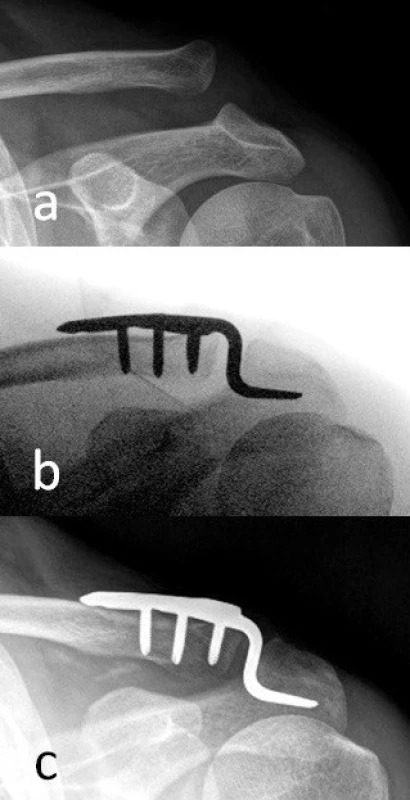
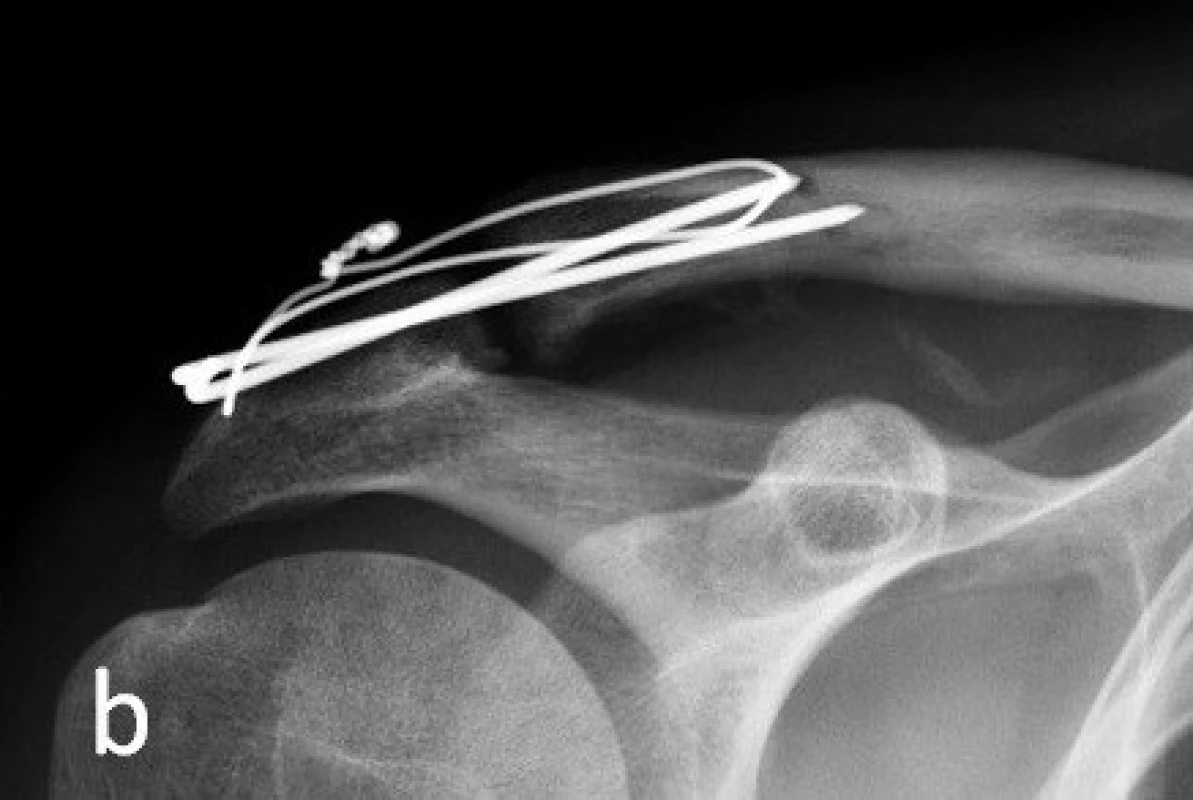
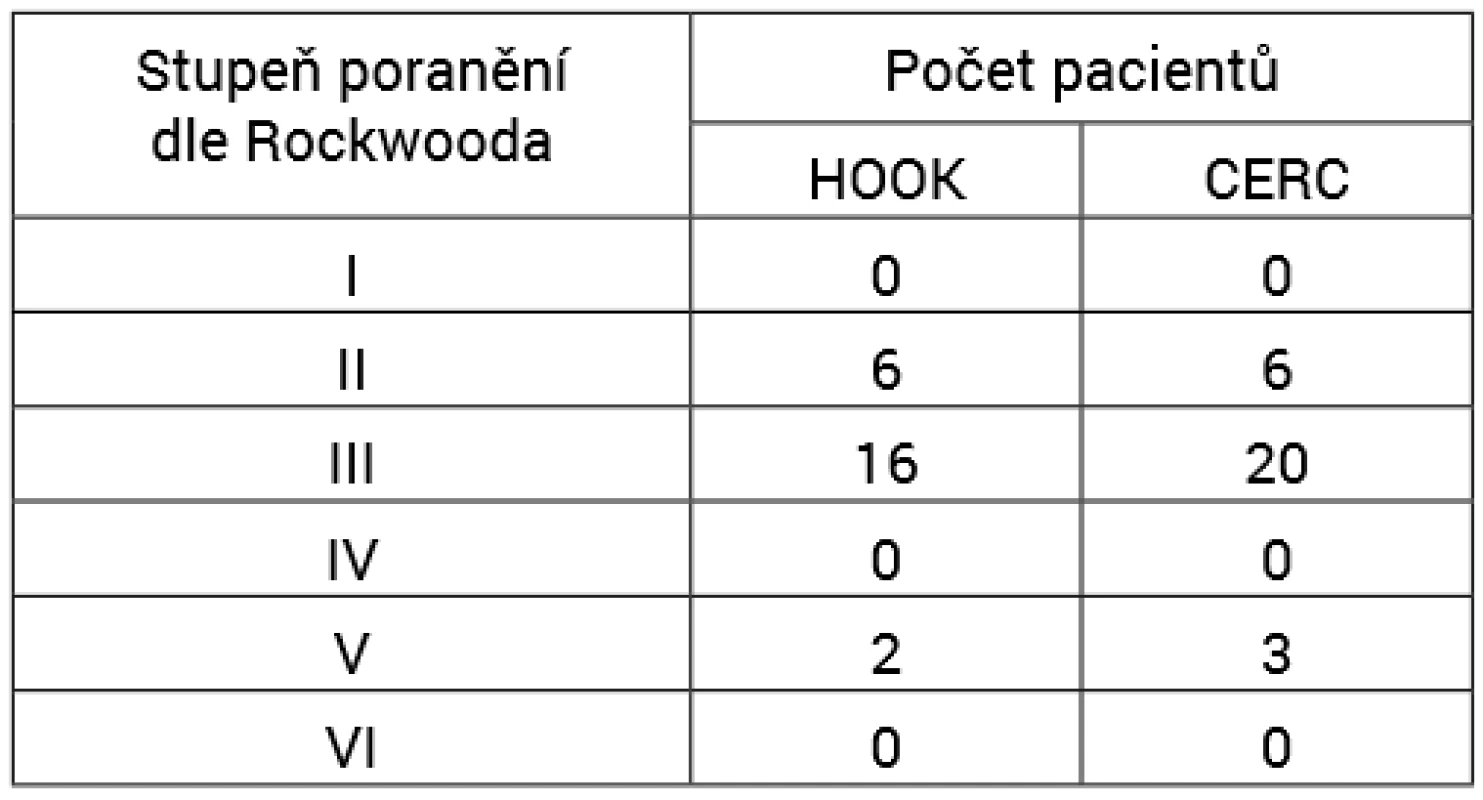
In the HOOK group, we penetrated by a longitudinal section over the AC articulation to its dislocation. Depending on the surgeon‘s choice, a vertical saber-cut approach to AC articulation was used in some cases. After repositioning the collarbone we used a hook plate to stabilize it. In the CERC group, we penetrated to the AC dislocation with a longitudinal surgical approach. After repositioning the collarbone, the anatomical position in the AC articulation was transfixed using the Kirschner wires (the K-wires) inserted through the lateral edge of the acromion into the collarbone. The tension wire band was then finished with a binding wire. We used the technique of tension wire band to remove the intraarticular disc, while when opting for the technique with the hook plate, we left the disc in situ. Suture of injured ligaments was not performed in any group.
In the postoperative period, we attached a hanging arm brace (Ortika, Hulín, Czech Republic) to all patients of both groups for 2–3 weeks. During this time, movement in the elbow, wrist and hand was allowed. This was followed by controlled rehabilitative care with full load of the affected shoulder three months after the surgery. X-ray evaluation was performed in the operating theatre and during regular outpatient examinations, where the clinical findings were simultaneously evaluated, we focused on swelling, haematoma, wound healing procedure, active range of movement and neurological limb deficit. The final evaluation was performed at least 6 months after the surgery.
Results
The mean follow-up of patients in the HOOK group was 7.1 months. In this group we did not notice any complications in surgical wound healing. The motility of the shoulder joint in the HOOK group was complete in 23 cases (95.8 %), in one case (4.2 %) the limitation of the shoulder abduction to 80° was persisting and it was not caused by non-anatomical healing (Tab. 2).
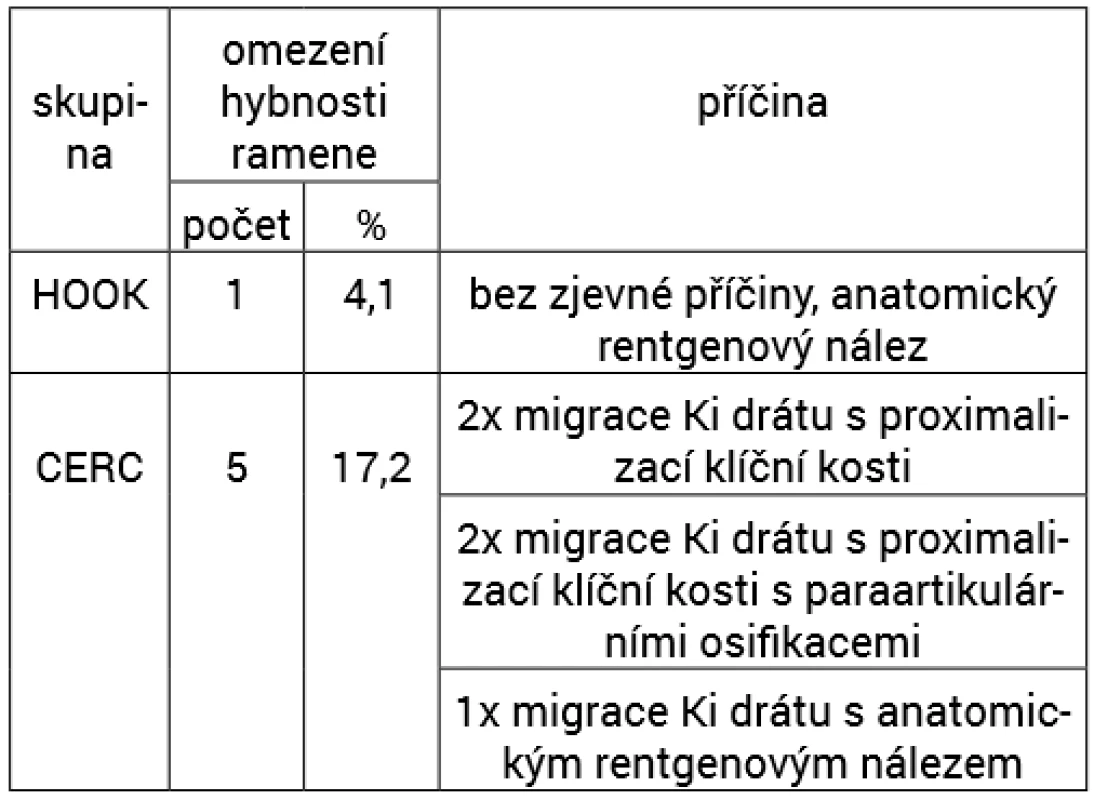
When evaluating peroperative X-ray images, we found anatomical position in 22 cases (91.7 %), in two cases (8.3 %) the anatomical conditions were not completely restored and the intraarticular space was extended to 8 mm, in one case to 9 mm, AC articulation width up to 5 mm was considered anatomical condition [19].
When evaluating X-rays before extraction of the osteosynthetic material, we found signs of osteolysis of the lower edge of the acromion in the HOOK group in 6 cases (25.0 %) (Fig. 3), in two cases (8.3 %) we diagnosed an extension of the intraarticular space from the original anatomical position to 8 mm, resp. 12 mm. In two cases (8.3 %) of the diastasis of the intraarticular space, already in the surgical X-ray image, in one case we observed another extension of the intraarticular space to 10 mm. In two cases (8.3 %) we observed the development of arthrosis of the AC articulation (Fig. 3), once (4.2 %) we diagnosed an osteophyte of the ventrolateral edge of the acromion, in six cases (25.0 %) porosis of the lateral portion of the collarbone and once (4.2 %) an osteophyte of the lateral portion of the collarbone. In four cases (16.7 %), we documented proximalization of the collarbone after extraction, in one case (4.2 %) a deficit of 6 mm, in the other three cases (12.5 %) 7 mm, in one case, this finding did not cause clinical discomfort to patients and was associated with full shoulder motility.
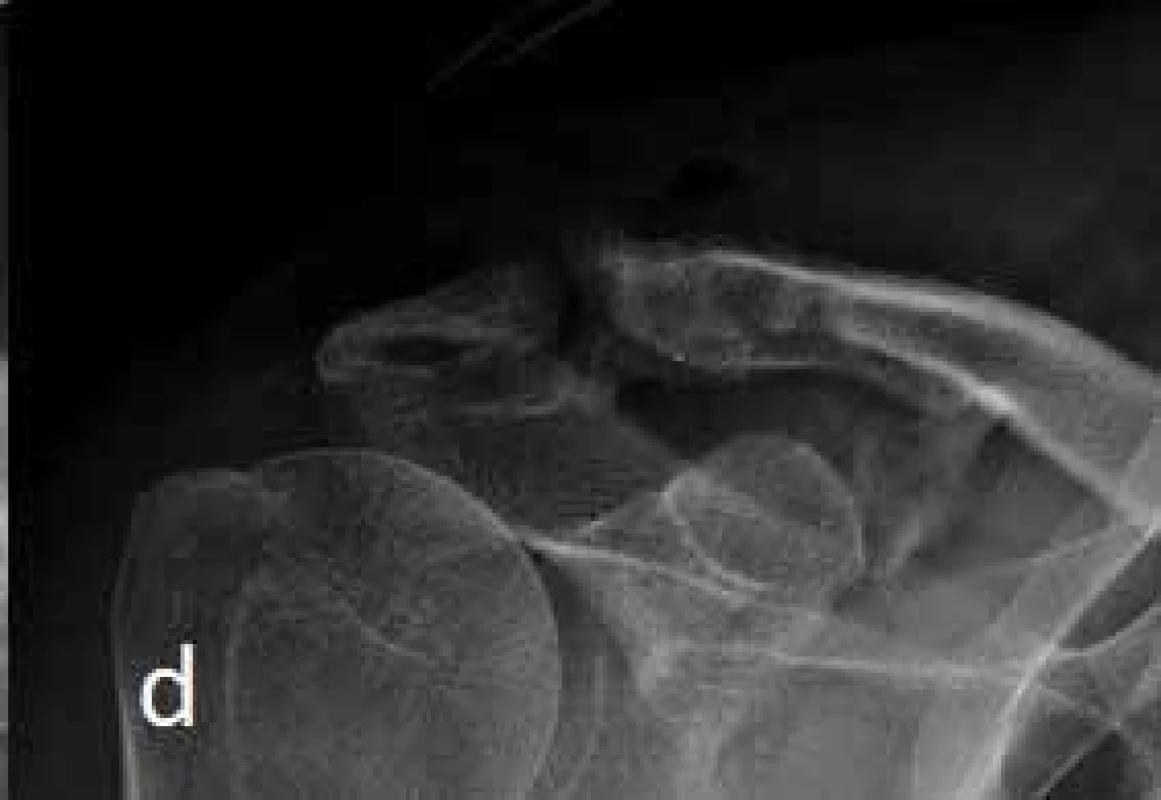
The mean follow-up of patients in the CERC group was 6.3 months. In the post-surgery period, soft tissue healing proceeded in this group without complications, in one case (3.4 %) wound dehiscence occurred after extraction of the osteosynthetic material. In this case, the abduction was reduced to 135°. In two cases of the total of three inverted dislocations, the abduction of the arm remained limited to 135° or to 150°. These patients with Rockwood II type injury were operated after unsuccessful conservative therapy for persistent pain and reduced motility at intervals of 49, 52 and 61 days after the injury. The range of motility in the CERC group was limited in five patients (17.2 %) (Tab. 2). Abduction in these five patients was reduced above 110°, 115°, in two patients above 135° and in another patient above 150°.
In three cases of the CERC group it was impossible to restore anatomical conditions and we found an extension of the synovial cavity to 13 mm in one X-ray (3.4 %), and in two cases (6.9 %) a proximal collar bone drop of 3 mm, respectively 7 mm.
In 14 cases (48.3 %) we demonstrated a migration of Kirschner wires on the radiograph before the extraction of the osteosynthetic material, in one case (3.4 %) a broken wire (Fig. 4). In one case (3.4 %), we observed dislocations to Rockwood II type when the bond was torn off the acromion, at the same time the K wire migration was detected (Fig. 5), where the patient remained without clinical symptoms and only material extraction was performed. In two cases (6.9 %) we observed a clavicular drop (of 3 mm, 10 mm) compared to the original anatomical position. In three cases (10.3 %) we observed an increase in para-articular ossifications, of which two cases required arthroscopic subacromial decompression. After extraction of the osteosynthetic material, the CERC group contained one case (3.4 %) of dislocations to the Rockwood II type, and in this patient an arthroscopic revision was performed for persistent pain and reduced motility.
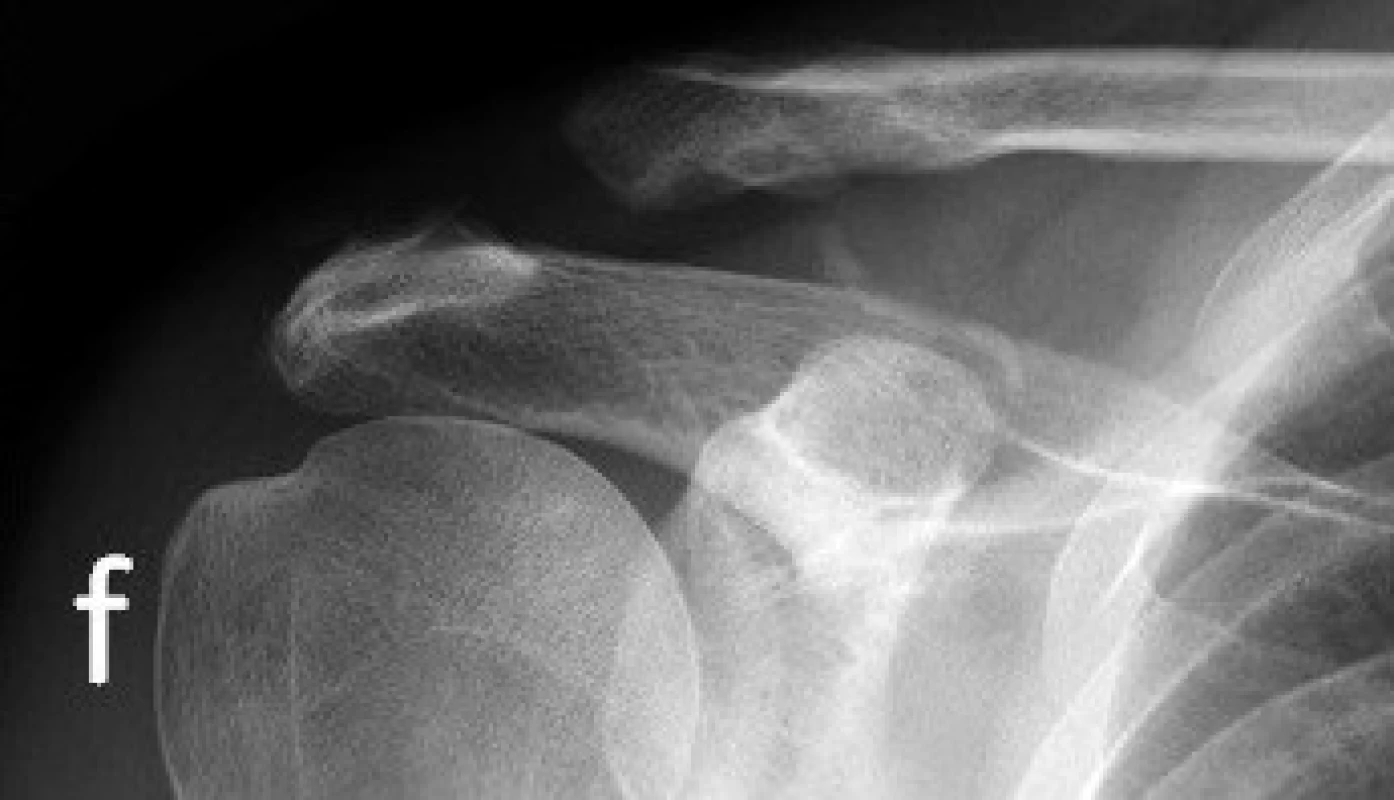
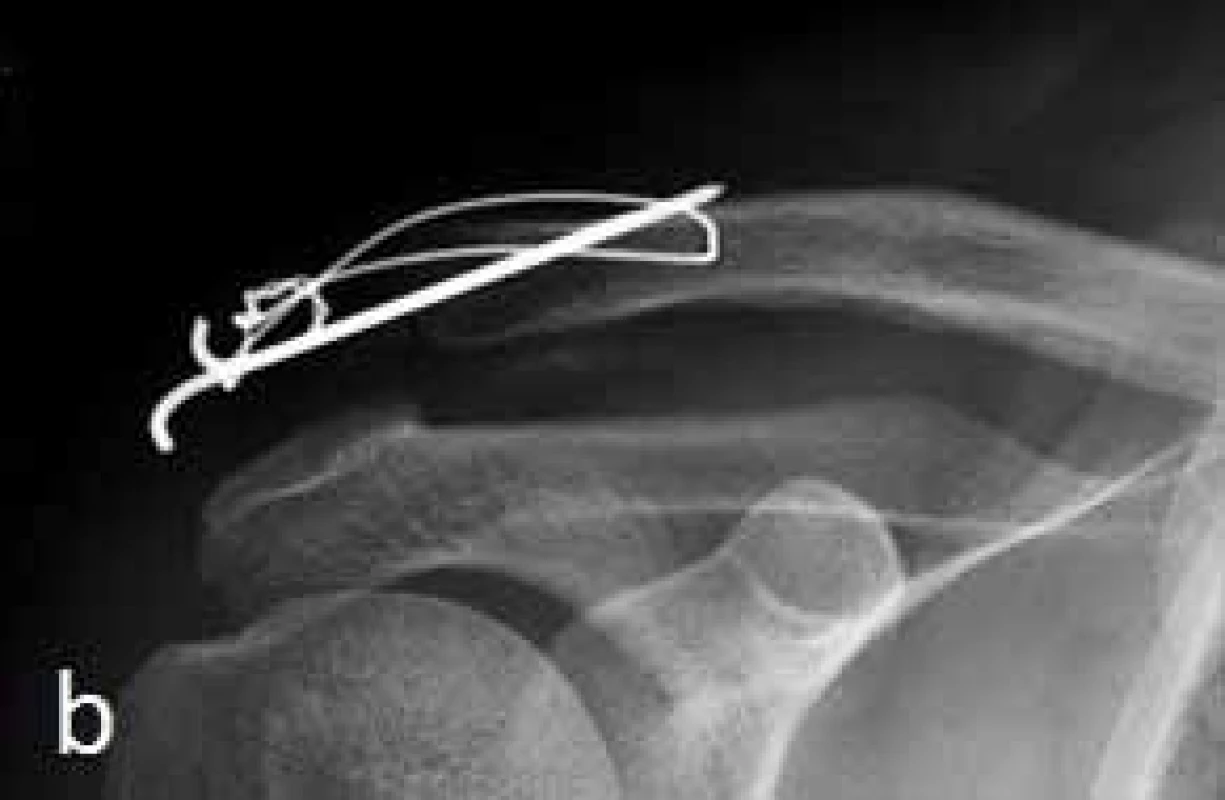
A comparison of numbers and an overview of the major complications of the HOOK and CERC groups is provided in the table (Tab. 3)
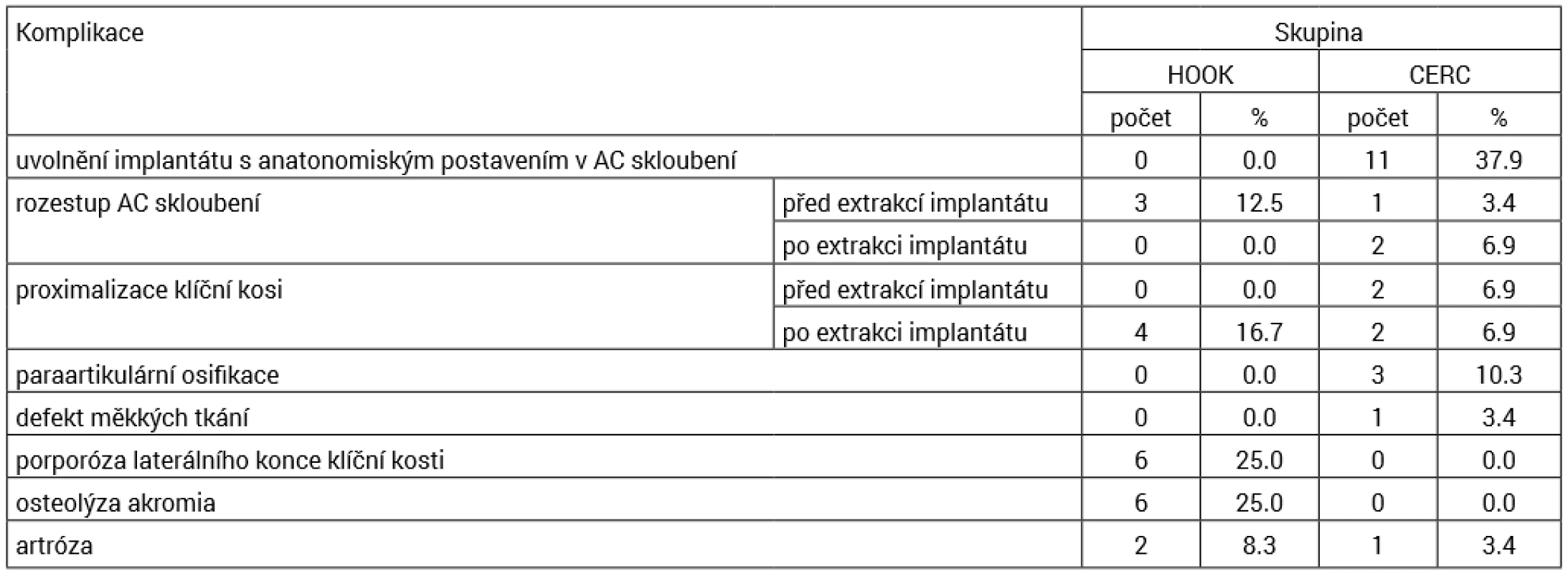
The resulting Constant score was 0.96 in the HOOK group and 0.89 in the CERC group.
The average time from surgery to extraction of osteosynthetic material was 5.8 months in the HOOK group and 4.0 months in the CERC group.
Hook plate extraction was performed in all 24 patients. Extraction of the tension wire cerclage was performed in all 29 cases, in six cases (20.7 %) under local anesthesia, of which in one case (3.4 %) in two times, when the migrating Kirschner wire was first removed under local anesthesia.
Discussion
Treatment of AC dislocations should be given attention in terms of the need for a good functional outcome since it is typical mostly for male in the third decade of life [34], our CERC and HOOK cohorts have confirmed this. They arise especially in contact sports [34], i.e. in patients active in sports, who expect full recovery of shoulder function. In our groups, AC dislocation occurred in 68.0% of patients during sport activity. Despite the high demands for good functionality, it is remarkable that the possibility of conservative therapy of 3rd degree dislocation is often mentioned in the contemporary literature [16]. Conservative treatment of AC dislocation of 3rd degree consists in fixation for different period of time, according to some works, 2 weeks are sufficient [2]. Even in Rockwood III-V injuries, functional differences in outcome between conservative and surgical therapy were not observed, conservatively treated patients returned earlier to work [13]. According to another study, types of Rockwood IV, V and VI injuries are clearly indicated for surgical therapy; surgical and conservative therapy is recommended for type III in literature [24]. The rate of return to sports tends to be comparable for different types of injuries and surgical procedures [14]. In Murray‘s current work, no advantage of surgical treatment was observed compared to conservative therapy for type III and IV dislocations according to Rockwood one year after the accident. However, a small percentage of patients treated conservatively require follow-up surgery [23]. However, two patients (66.7 %) of our CERC group who were operated later after injury showed worse functional outcomes than patients operated early after the injury. In cases of unsuccessful conservative therapy leading to symptomatic arthrosis, a modified Weaver-Dunn operation is recommended that has better therapeutic results than band for fresh injuries, and does not require subsequent metal extraction [16].
In the CERC sample a failed band stability was observed in a total of 14 times (48.3 %) with 11 times (37.9 %) occurring migration of K wires, once (3.4 %) associated with subsequent rupture of the binding wire and once (3.4 %) band cut itself through acromion. Not in all cases, however, the migration was associated with the resulting unsatisfactory collarbone positioning with respect to acromion. However, according to our findings, these complications led to a slowdown in rehabilitation and in five patients the shoulder was not exercised well after six months of surgery. We observed redislocation in the CERC cohort once (3.4 %). Recurrence of AC dislocation after tension wire band is reported in up to 8 % [18]. In other locations, the mentioned greater stability of tension wire band in comparison with simple transfixing with K wires is questionable here. A recent study does not identify differences in results of treatment by stabilizing with K wires only and stabilizing using tension wire band, but both methods are associated with multiple cases of wire migrations [3]. Our study unequivocally confirmed the frequent migration of K wires using band. The question remains at what time distance we should indicate band extraction. Extraction after 12 weeks may result in a slight secondary dislocation of about 7 mm [32]. From this point of view, we can consider our average operation - extraction interval of 4 months to be adequate. Such cerclage with the use of two K wires exhibits reduced stability in rotational movements occurring at an abduction above 90°. Thus, a suggestion to reduce the number of band failures would be to recommend reducing the intensity of rehabilitation prior to extraction rather than reducing the time that the band is left in situ [26].
In terms of stability, our HOOK group performed better, with no failure in any of the cases. The complications of the HOOK group were mainly due to excessive pressure: the lateral part porosis of the clavicle appeared at six times (25.0 %), and pressure osteolysis of acromion in six patients (25.0 %). According to the geometric model, the risk of acromial erosion upon hook plate stabilizing is determined by individual anatomical conditions [29]. These X-ray findings cannot be understood as a complication since they did not limit the rehabilitation process in any way, did not reduce mobility and are merely a reason for the implant extraction. Partial redislocation [9] may occur after extraction using the hook plate during stabilization, but this complication was not found in our HOOK file. Only one patient (4.2 %) in the HOOK group had persisting movement limitations in six months after the surgery, but this was not a result of any radiologically detectable complication.
The advantage of the hook plate consists in the immediate stability allowing very early initiated rehabilitation [27, 32]. A recent finding based on computer simulations according to which a hook plate may lead to blade dyskinesia is interesting [15], but this complication was not observed in our cohort.
The common disadvantage of stabilization using tension wire band and hook plate is the necessity of two surgical interventions. The CERC and HOOK cohorts required metal implant extraction in all patients. The extraction time of the stabilizing material is variable, in some publications it is stated that a period of 5 weeks after surgery is sufficient [17]. In our case it was a longer time, in the CERC sample on average 4.0 months, in the HOOK sample 5.8 months.
During the stabilization using the tension wire band, we removed the intra-articular disc during the surgery, while it was left in situ while using the hook plate. According to studies, this disc is perceived as a stabilizing “co-factor“, but its clinical significance has never been proven [20]. In our opinion, preserving or extracting this disc does not affect the therapeutic outcome. The size of the disk is very variable in the population, in some cases it is not developed at all. According to studies, at the beginning of the second decade of life, this structure undergoes rapid degeneration and by the fourth decade this degeneration becomes significant [16].
Reconstructive surgeries using tendon grafts can bring good results with reduce operation risk. The method of reconstruction of CC and AC ligaments using ligament grafts also leads to excellent results, like the hook plate stabilization [33]. According to biomechanical studies, anatomical reconstruction using tendon grafts minimizes pain and allows early rehabilitation [22]. Minimum complications are described in tendon graft stabilization by arthroscopic methods [6, 19]. Reconstructions, respectively stabilizations with special fibres are also employed. According to studies, the stabilization with the hook plate is associated with pain often occuring in the postoperative period, but this method is accompanied by fewer complications than stabilization using loop fixation [1].
What types of AC dislocations should be indicated for surgery [28]? Analysis of a large number of publications has clearly shown that surgical treatment of type III injuries is more likely to be associated with complications than conservative treatment [4]. A large-scale recent study in the UK determined that all of the 137 specialists in the treatment of shoulder disorders interviewed would indicate an early stage type III AC dislocation for conservative therapy, and surgical treatment would only be chosen if it failed, on average 3.8 months after injury [7]. In our CERC and HOOK cohorts the injury-to-surgery interval was significantly shorter, but it did not stem from the attempt for conservative therapy but from the technical possibilities of the relevant workplace. In this context, it is worth considering whether we should indicate so many patients for surgery. Functional results at 3 months may be better with surgical therapy, but they are identical and consistent in just one year after surgery [17]. The original classification according to Tossy dates back to 1963 [30]. The most frequently applied present classification is actually this original one by Rockwood extended by another 3 types of injuries and dates back to 1984 [35]. Practicality is based on the fact that these other three types of injuries are indications for surgical treatment, while for all types described by Tossy, many authors still prefer conservative treatment. However, a clinical issue may be the distinction of type III, IV and V. According to a recent study, the Rockwood classification is X-ray-based and does not correspond to the patient‘s clinical difficulties. Its applicability to the “management” of AC dislocation treatment is unclear [10]. When evaluating X-rays it is also necessary to think of individual differences. CT analysis revealed that there are three possible variants physiologically (prominen acromion – 46 % of population, neutral position – 38 % and prominent collar bone 16 %) [5]. In some cases, injury of second degree is not recognized from injury of third degree. The 3rd degree injury is defined as an increase in coracoclavicular distance (CC distance, Fig. 6) by more than 100 % compared to the healthy side, with IV and V the increase is even higher [34]. For this purpose, it is necessary to make a contralateral radiograph, which does not make part of our standard practice. Axial projection is advantageous to recognize degree III and IV of severity [27]. To differentiate between type II and type IV injuries, sonographic examination is preferable [12].
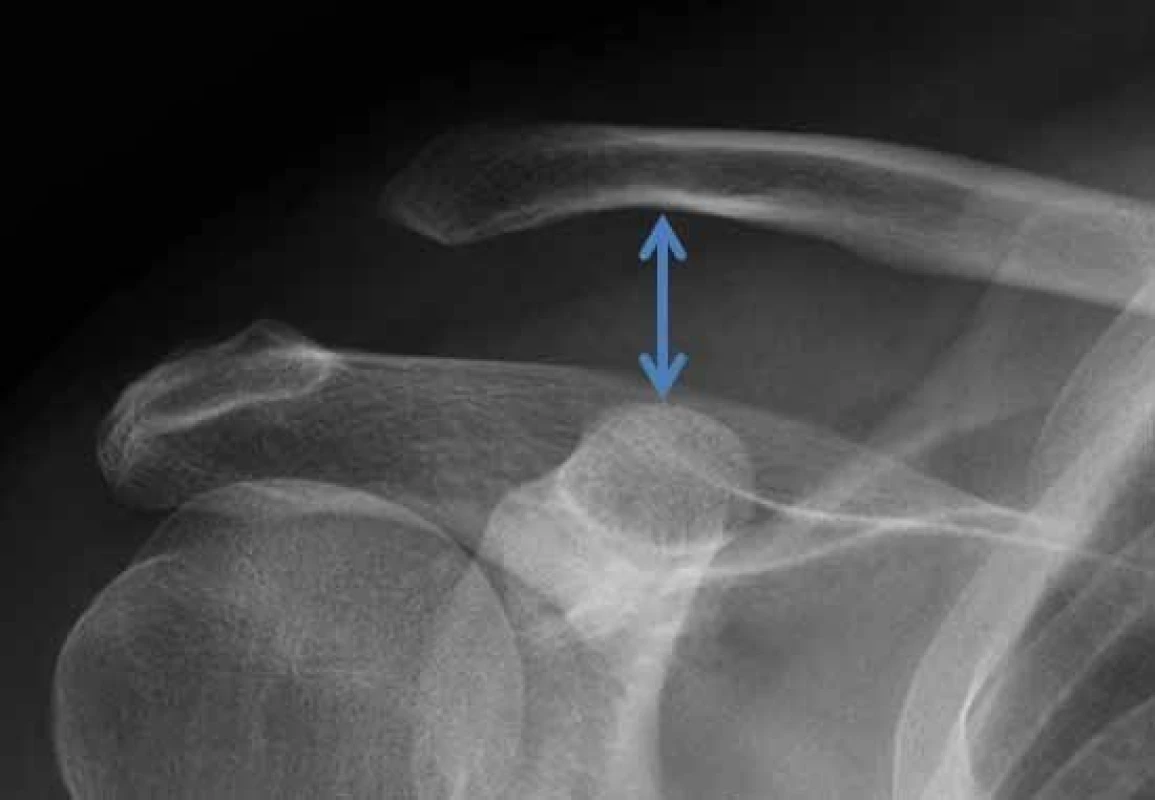
According to very recent views, type I and type II injuries are indicated for conservative treatment and type IV, V and VI are clearly indicated for surgical treatment. The optimum solution for type III injuries is still questionable [26]. Often, the indication is merely a „cosmetic“ matter where removal of the defiguration of the acromioclavicular articulation does not lead to improved functionality. However, this cosmetic effect has been devalued by the often unsatisfactory postoperative scar in surgical methods associated with an extensive surgical approach.
More than a hundred techniques have been described for surgical treatment of AC dislocations [24], which one to choose then? An extensive meta-analytical study evaluating the results published in 58 articles about a total of 1704 patients concludes that different surgical techniques achieve the same outcome of treatment of AC dislocations in terms of failure and number of complications [11]. CERC group was clearly associated with a higher number of complications in our cohorts; the overall occurrence of limited shoulder mobility is particularly significant (17.2 % versus 4.2 % in the HOOK group). This fact is also documented by the CERC group‘s worse results in terms of the Constant score. Overall, almost half of the CERC group had an implant loosening, so this method cannot be considered as completely stable. This finding must necessarily be a factor limiting the time to start rehabilitation. In the HOOK group, the implant loosening was not detected at all, so patients treated with this method may be advised to start rehabilitation very early after surgery. Further patient follow-up would be needed to evaluate outcomes; the possibility of improving the motility of the shoulder after six months from the surgery can surely be assumed. The aim of our study, however, was not to document the resulting functional state that many studies describe in both surgical methods as similar [11], but to evaluate the rate of possible full recovery of motility in both groups.
Conclusion
Clinical results after surgical treatment of acromioclavicular dislocations using hook plate and tension wire band bring about good results. Implant extraction is indicated for both methods in all cases. In the period of six months after the surgery, there is more frequent limitation of motility when using tension wire band, especially in connection with the migration of Kirschner wires. Stabilization with a hook plate is affected by fewer complications.
MUDr. Jonáš David
Zdroje
- ARIRACHAKARAN, A., BOONARD, M., PIYAPITTAYANUN, P. et al. Post-operative outcomes and complications of suspensory loop fixation device versus hook plate in acute unstable acromioclavicular joint dislocation: a systematic review and meta-analysis. J Orthop Traumatol. 2017, 18, 293–304. ISSN 1877-0568
- BANNISTER, GC, WALLACE, WA, STABLEFORTH, PG et al. The Management of acute acromioclavicular dislocation. J Bone Joint Surg Br. 1989, 71, 848–850. ISSN 2044-5377
- BIZ, C., BERIZZI, A., CAPPELLARI, A. et al. The treatment of acute Rockwood type III acromio-clavicular joint dislocations by two different surgical techniques. Acta Biomed. 2015, 86, 251–259. ISSN: 0392-4203
- CECCARELLI, E., BONDÌ, R., ALVITI, F. et al. Treatment of acute grade III acromioclavicular dislocation: a lack of evidence. J Orthop Traumatol. 2008, 9, 105–108. ISSN 1877- 0568
- CRÖNLEIN, M., POSTL, L., BEIRER, M. et al. Analysis of the bony geometry of the acromio-clavicular joint. Eur J Med Res. 2018, 23, 50. ISSN 2047-783X
- DE BERARDINO, TM, PENSAK, MJ, FERREIRA, J. et al. Arthroscopic stabilization of acromioclavicular joint dislocation using the AC graftrope system. J Shoulder Elbow Surg. 2010, 19, 47–52. ISSN 1058-2746
- DOMOS, P., SIM, F., DUNNE, M. et al. Current practice in the management of Rockwood type III acromioclavicular joint dislocations-National survey. J Orthop Surg (Hong Kong). 2017, 25, 1-6. ISSN: 1022-5536
- DOU, Q., REN, X. Clinical therapeutic effects of AO/ASIF clavicle hook plate on distal clavicle fractures and acromioclavicular joint dislocations. Pak J Med Sci. 2014, 30, 868–871. ISSN 1682 024X
- ESCHLER, A., GRADL, G., GIERER, P. et al. Hook plate fixation for acromioclavicular joint separations restores coracoclavicular distance more accurately than PDS augmentation, however presents with a high rate of acromial osteolysis. Arch Orthop Trauma Surg. 2012, 132, 33–39. ISSN 1434-3916
- GRANVILLE-CHAPMAN, J., TORRANCE, E., RASHID, A. et al. The Rockwood classification in acute acromioclavicular joint injury does not correlate with symptoms. J Orthop Surg (Hong Kong). 2018, 26, 1–5. ISSN 1749-799X
- GOWD, AK., LIU, JN., CABARCAS, BC. et al. Current concepts in the operative management of acromioclavicular dislocations: A systematic review and meta-analysis of operative techniques. Am J Sports Med. 2019, 47, 2745–2758. ISSN 1552-3365
- HEERS, G., HEDTMANN, A. Ultrasound diagnosis of the acromioclavicular joint. Orthopade. 2002. 31, 255-261. ISSN: 0085-4530
- CHANG, N., FUREY, A., KURDIN, A. Operative versus nonoperative management of acute high-grade acromioclavicular dislocations: A systematic review and meta-analysis. J Orthop Trauma. 2018, 32, 1–9. ISSN 1877-0568
- KAY, J., MEMON, M., ALOLABI, B. Return to sport and clinical outcomes after surgical management of acromioclavicular joint dislocation: A systematic review. Arthroscopy. 2018, 34, 2910–2924. ISSN 1526-3231
- KIM, E., LEE, S., JEONG, HJ, et al. Three-dimensional scapular dyskinesis in Hook-plated acromioclavicular dislocation including hook motion. J Shoulder Elbow Surg. 2018, 27, 1117–1124. ISSN 1058-2746
- KOVILAZHIKATHU SUGATHAN, H., DODENHOFF, RM. Management of type 3 acromioclavicular joint dislocation: comparison of long-term functional results of two operative methods. ISRN Surg. 2012, 1–6. ISSN 2090-5793
- LARSEN, E., BJERG-NIELSEN, A., CRISTENSEN, P. Conservative or surgical treatment of acromioclavicular dislocation. J Bone Joint Surg Am. 1986, 68, 552–555. ISSN 1535-1386
- LATEUR, G., BOUDISSA, M., RUBENS-DUVAL, B. et al. Long-term outcomes of tension band wiring with a single K-wire in Rockwood type IV/V acute acromio-clavicular dislocations: 25 cases. Orthop Traumatol Surg Res. 2016, 102, 589–593. ISSN 1877-0568
- LEE, SJ, YOO, YS, KIM, YS. et al. Arthroscopic coracoclavicular fixation using multiple low-profile devices in acute acromioclavicular joint dislocation. Arthroscopy. 2019, 35, 14–21. ISSN 1526-3231
- MAIER, D., JAEGER, M., REISING, K. et al. Injury patterns of the acromioclavicular ligament complex in acute acromioclavicular joint dislocations: a cross-sectional, fundamental study. BMC Musculoskelet Disord. 2016, 17, 385. ISSN: 1471-2474
- MARINČEK, B., DONDELINGER, RF. Emergency radiology, imaging and intervention. Heidelberg: Springer Verlag, 2006. ISBN: 354026227X
- MAZZOCCA, AD, SANTANGELO, SA, JOHNSON, ST et al. A biomechanical evaluation of an anatomical coracoclavicular ligament reconstruction. Am J Sports Med. 2006, 34, 236–246. ISSN 1552-3365
- MURRAY, IR, ROBINSON, PG, GOUDIE, EB et al. Open reduction and tunneled suspensory device fixation compared with nonoperative treatment for type-III and type-IV acromioclavicular joint dislocations: The ACORN prospective, randomized controlled trial. J Bone Joint Surg Am. 2018, 100, 1912–1918. ISSN 1535-1386
- NORTH, AS, WILKINSON, T. Surgical reconstruction of the acromioclavicular joint: Can we identify the optimal approach? Strategies Trauma Limb Reconstr. 2018, 13, 6974. ISSN 1828- 8928
- PHADKE, A., BAKTI, N., BAWALE, R. et al. Current concepts in management of ACJ injuries. J Clin Orthop Trauma. 2019, 10, 480–485. ISSN 0976-5662
- SACCOMANNO, MF, DE IESO, C., MILANO, G. Acromioclavicular joint instability: anatomy, biomechanics and evaluation. Joints. 2014, 2, 87–92. ISSN 2282-4324
- SALEM, KH, SCHMELZ, A. Treatment of Tossy III acromioclavicular joint injuries using hook plates and ligament suture. J Orthop Trauma. 2009, 23, 565–569. ISSN 1877-0568
- SEIJAS, R., SALLENT, A., ARES, O. Rockwood type III acromioclavicular joint dislocation; Are we still fighting? J Invest Surg. 2018, 31, 234–235. ISSN 0894-1939
- SHEN, PC, ZHU, Y., ZHANG, H. et al. Three-dimensional morphological analysis of acromioclavicular joint in patiens with and without subacromial erosion after hook plate fixation. J Int Med Res. 2018, 46, 511–521. ISSN 0300-0605
- TOSSY, JD, MEAD, NC, SIGMOND, HM. Acromioclavicular separations: Useful and practical classification for treatment. Clin Orthop Relat Res. 1963, 28, 111–119. ISSN 1528-1132
- TRÁVNÍK, J., KOVAŘÍK, J., PAVLACKÝ, T. et al. Stabilizace akromioklavikulární luxace tahovou cerkláží ve srovnání s jedním Kirschnerovým drátem doplněným kličkou z částečné vstřebatelného materiálu - nerandomizovaná retrospektivní studie. Acta Chir Orthop Traumatol Cech. 2019, 86, 131–135. ISSN 0001-5415
- TUČEK, M., CHOCHOLA, A., VANĚČEK, V. et al. Chirurgická léčba akromioklavikulární luxace: Tahová cerkláž versus hákovitá dlaha. Rozhl Chir. 2015, 94, 437–444. ISSN 1805-4579
- WANG, G., XIE, R., MAO, T. et al. Treatment of AC dislocation by reconstructing CC and AC ligaments with allogenic tendons compared with hook plates. J Orthop Surg Res. 2018, 13, 175. ISSN 1749-799X
- WARTH, RJ, MARTETSCHLÄGER, F., GASKILL, TR et al. Acromioclavicular joint separations. Curr Rev Musculoskelet Med. 2013, 6, 71–78. ISSN 1935-9748
- WILLIAMS, GR, NGUYEN, VD, ROCKWOOD, CA. Classification and radiographic analysis of acromioclavicular dislocations. Appl Radiol. 1989, 18, 29–34. ISSN 0160-9963
Štítky
Chirurgie všeobecná Traumatologie Urgentní medicínaČlánek vyšel v časopise
Úrazová chirurgie
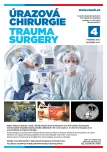
2018 Číslo 4
- Metamizol jako analgetikum první volby: kdy, pro koho, jak a proč?
- MUDr. Lenka Klimešová: Multioborová vizita může být klíčem k efektivnější perioperační léčbě chronické bolesti
- Realita léčby bolesti v paliativní péči v Německu
- Příčiny a možnosti ovlivnění bolesti předního kolene po implantaci totální endoprotézy
Nejčtenější v tomto čísle
- INTRA-ARTICULAR DISLOCATION FRACTURES OF THE MIDDLE PHALANX BASE - CASE REPORTS OF INCORRECT TREATMENT PROCEDURES, CURRENT TREATMENT CONCEPTS
- Non-unions after intramedullary nailing of fractures of the humeral diaphysis
- Therapeutic results of acromioclavicular dislocations by means of a hook plate and tension wire band
- Conservative and surgical treatment of fractures of articular process of mandible in adults










